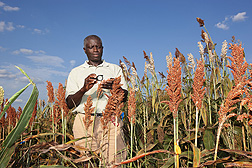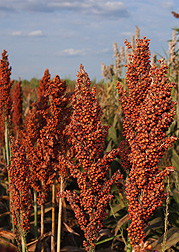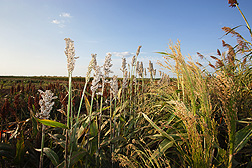Reducing Sorghum’s Major Limitations
Cold Tolerance and Diseases
|
|
In the world of cereal crops, sorghum is as versatile as they come. Extremely drought tolerant, it grows in marginal areas and produces so much biomass that some researchers are exploring whether it can be used as a biofuel. It is an important part of the human diet in India, Africa, and parts of Japan, and while it is used in the United States primarily in animal feed, it is a major U.S. export and is sold domestically to make gluten-free flour.
But sorghum has its limitations. It is highly susceptible to diseases and is not cold tolerant. Agricultural Research Service scientists in College Station, Texas, are developing tools to help combat the diseases that can wipe out entire fields of sorghum. Colleagues in Lubbock, Texas, are hunting for genes that they can use to develop cold-tolerant lines and expand the range of what was originally a tropical plant.
Some Like It Cold
Commercially, sorghum will not grow well in areas where soil temperatures fall below 59°F during early-season planting. But a team of ARS scientist and technicians in Lubbock is out to change that. Plant physiologist Gloria Burow and colleagues John J. Burke and Zhanguo Xin, along with technicians Halee Hughes and Charlie Woodfin, have joined with Cleve Franks, a scientist at Pioneer Hi-Bred International, to search for genes in cultivars from China that can be used to develop cold-tolerant lines. If they can increase sorghum’s cold tolerance, it could be planted earlier, and its range in the Midwest could be extended beyond the Sorghum Belt that now stretches from Texas to Kansas and parts of Nebraska. The researchers want to extend it into the Dakotas and west to Colorado, Burow says.
|
|
Burow, Xin, and Burke are in the Plant Stress and Germplasm Development Research Unit at the ARS Cropping Systems Research Laboratory in Lubbock.
Burow and her colleagues spent 3 years evaluating 200 sorghum accessions from China, where the plant is known for its cold tolerance. They took one of the most promising cold-tolerant lines, accession PI610727, crossed it with a cold-sensitive sorghum variety, and produced 171 inbred lines. They raised those lines at sites in Texas and recorded soil and air temperatures to assess the cold tolerance of each plant. They also extracted DNA from the leaves and used simple sequence repeat markers to genotype them, essentially matching up markers found in individual plants with their cold hardiness, measured as the ability to germinate early and to produce robust seedlings under cold conditions.
They also evaluated each line in petri dishes at cold temperatures and at optimal temperatures for seed germination. The results, published in the September 2011 issue of Molecular Breeding, include a genetic map of 141 genetic markers that will make it easier for breeders to identify cold tolerance in sorghum plants. The researchers also found several lines with superior cold tolerance that could be useful for breeding commercially viable cold-tolerant cultivars.
They have released the 171 inbred lines to breeders and research groups through the ARS Germplasm Resources Information Network, and at least two research groups have requested additional information on that population so far. The work is continuing, with germplasm being evaluated at four locations in Texas, Kansas, and South Dakota. Support for that work is being provided by the U.S. United Sorghum Checkoff Program, a grower-funded effort to improve sorghum.
“We have to be able to show breeders and growers that what we can offer them will grow in different locations and under different soil conditions,” Burow says.
The effort could lead to higher yields and plants that tap more moisture from the soil. “If you have cold-tolerant sorghum, you can plant your crop earlier, and if you can plant earlier, you can take advantage of moisture in the soil in the springtime, so that indirectly you have a mechanism for drought tolerance. You could also have two growing cycles in a year,” says Burow.
|
|
Fighting Sorghum Diseases
At the ARS Crop Germplasm Research Unit in College Station, Texas, plant pathologist Louis K. Prom is developing tools to help combat diseases that can wipe out entire fields. He is focused on three of the pathogens that are evolving threats to sorghum worldwide: head smut, anthracnose, and grain mold.
Head smut is asoilborne fungal pathogen that infects sorghum plants at the seedling stage, but symptoms appear at flowering, and infected plants are unable to produce grain. Head smut can’t be controlled with rotation or chemicals, and it is found all over the world. Once the fungus is in the soil, it is difficult to eradicate, and the only way to prevent head smut is by growing resistant cultivars. But breeders and growers can only screen for head smut by growing plants in fields where there are high levels of it and then observing the results. Only after several years can they tell whether plants are resistant. Even then, if soil temperatures are too high or too low, it can reduce infection rates and throw off the results.
Head smut is also an increasing problem in coastal Texas. “Two years ago, we toured an area in South Texas, and the growers and extension agents showed us infected areas where they had never seen head smut before,” says Prom.
To speed up monitoring efforts, Prom and his colleagues evaluated 4 techniques for screening sorghum for head smut resistance using 32 isolates of the pathogen collected from different parts of Texas. Inoculated plants were grown in greenhouses to ensure uniform results. The results, published in May 2011 in Plant Disease, show that the most reliable method involves injecting 18- to 20-day-old plants with a solution that includes head smut fungal spores in suspension.
Anthracnose is the most important foliar disease of sorghum worldwide, and grain mold is the crop’s most significant overall threat. Grain mold costs U.S. growers $130 million a year. Host plant resistance remains the most effective control mechanism for these threats, too.
To help growers combat the diseases, Prom screened 39 sorghum accessions over 2 years for resistance to anthracnose and several of the most common types of grain mold fungi. He found one accession from Uganda, labeled “PI534117,” that is both highly resistant to anthracnose and shows very little evidence of grain mold infection. The results, published in May 2011 in Crop Protection, also show that the cultivar has a high germination rate, good seed qualities, and a short stature, which altogether make it a good candidate for Texas growers.—By Dennis O'Brien, Agricultural Research Service Information Staff.
The research is part of Plant Diseases (#303) and Plant Genetic Resources, Genomics, and Genetic Improvement (#301), two ARS national programs described at www.nps.ars.usda.gov.
To reach scientists mentioned in this article, contact Dennis O’Brien, USDA-ARS Information Staff, 5601 Sunnyside Ave., Beltsville, MD 20705-5129; (301) 504-1624.
"Reducing Sorghum’s Major Limitations: Cold Tolerance and Diseases" was published in the October 2012 issue of Agricultural Research magazine.










